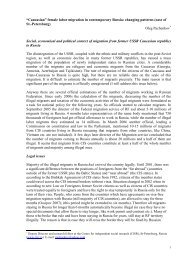THORIUM AS AN ENERGY SOURCE - Opportunities for Norway ...
THORIUM AS AN ENERGY SOURCE - Opportunities for Norway ...
THORIUM AS AN ENERGY SOURCE - Opportunities for Norway ...
Create successful ePaper yourself
Turn your PDF publications into a flip-book with our unique Google optimized e-Paper software.
Thorium as an Energy Source - <strong>Opportunities</strong> <strong>for</strong> <strong>Norway</strong><br />
Concerning nuclear energy, the Commission stated that it is one of the largest sources of CO2 free<br />
energy in Europe but it is up to the member states to decide future developments. In 2004 the 152<br />
reactors in the EU produced on average 6.7 TWhe (Tera Watt Hours Electricity) per reactor<br />
corresponding to 15 % of the EU energy consumption or 31 % of the electricity consumption. To<br />
replace aging reactors, 50 new reactors need to be built be<strong>for</strong>e 2030. Safer operation and<br />
improved waste management will successively be implemented, an example being the new<br />
Finnish reactor. Although existing nuclear power plants are very competitive, high capital costs<br />
of any new nuclear investment greatly increase the business risk of nuclear energy <strong>for</strong> companies<br />
operating on purely market based conditions.<br />
The 2004 EU consumption of renewable electricity is: hydro 304 TWh, wind 59 TWh, biomass 69<br />
TWh and of nuclear electricity 986 TWh.<br />
In the EU the role of the stock market in electricity trading can be predicted to increase.<br />
Currently, in the Nord Pool area more than 70 % of consumed electricity is traded via stock (Nord<br />
Pool became in 1996 the first international commodity exchange <strong>for</strong> trading electric power). This<br />
applies also to emission allowance trading, where the volume traded through stock is<br />
continuously increasing.<br />
2.4 The Situation in <strong>Norway</strong><br />
The oil and gas industry is <strong>Norway</strong>'s largest and most important industry. Since the start-up of<br />
activities on the Norwegian Continental Shelf (NCS) in the early 1970s, the industry has been<br />
characterised by growth and increased production. The situation today is different; oil production<br />
decreases every year and only a few discoveries are ready <strong>for</strong> development. At the same time,<br />
there are large expected resources on the NCS which remain to be proven. In spite of more than<br />
30 years of production, only around one third of the total expected resources on the NCS have<br />
been extracted.<br />
Norwegian oil production has remained at a plateau level of about 3 million barrels per day (bpd)<br />
since 1995, which is about 3.5 % of the world production, of which about 2.5 million bpd are<br />
exported. This makes <strong>Norway</strong> the world's tenth-largest oil producer and fifth-largest oil exporter.<br />
In a few years, oil production is expected to gradually decrease. From representing approximately<br />
35 % of the total Norwegian petroleum production in 2006, gas production will probably increase<br />
its share to more than 50 % in 2013. The production of petroleum in <strong>Norway</strong>, which includes oil,<br />
gas, NGL (Natural Gas Liquids, a collective term <strong>for</strong> grades of liquid petroleum) and condensate<br />
(a type of light oil that contains a proportion of wet gas) from 1971 to 2006, is shown in Figure<br />
2.4. In the longer term, the number and sizes of new discoveries will be a critical factor <strong>for</strong> the<br />
production level.<br />
10

















